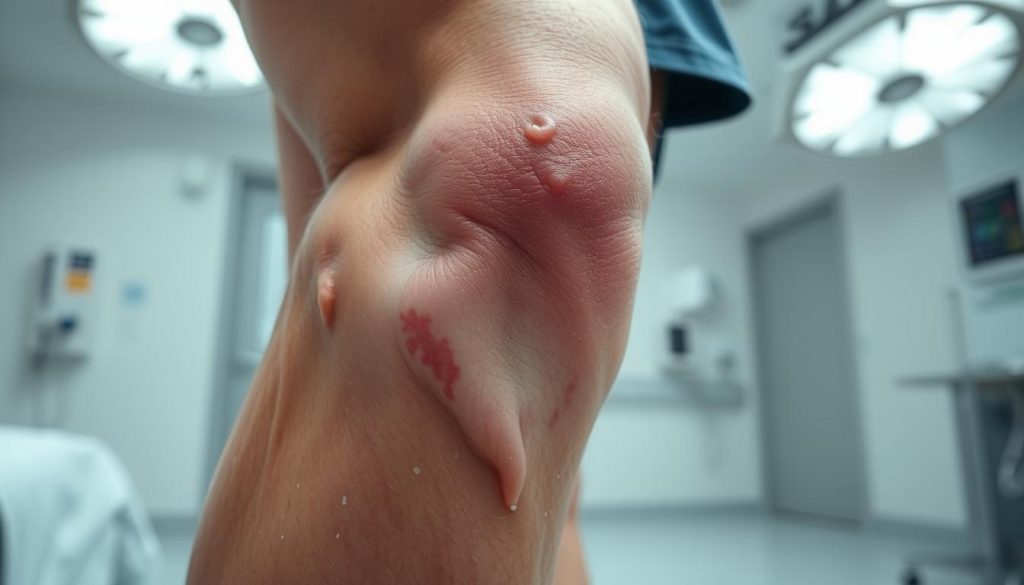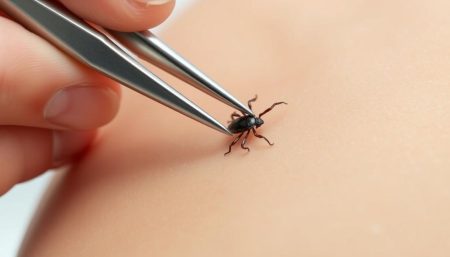ACL surgery is common among athletes and active people. Most recover well, but it’s important to watch for bad signs. Spotting these early can prevent problems and help healing.
It’s key to know about ACL surgery complications. Look out for too much pain, swelling, or infection. Knowing what’s normal helps patients get help when needed.
This guide talks about warning signs after ACL surgery. It helps people tell normal discomfort from serious issues. Being informed helps take control of recovery.
Understanding Normal vs Abnormal ACL Surgery Recovery
It’s key to know the signs of a good or bad ACL surgery recovery. Patients must understand what’s normal and what’s not. This way, they can get help fast if they need it.
Timeline of Expected Recovery Milestones
ACL recovery has a set timeline. Most people can walk without crutches in 2-4 weeks. By 6-8 weeks, they usually move their knee fully again. Light sports activities can start around 4-6 months after surgery.
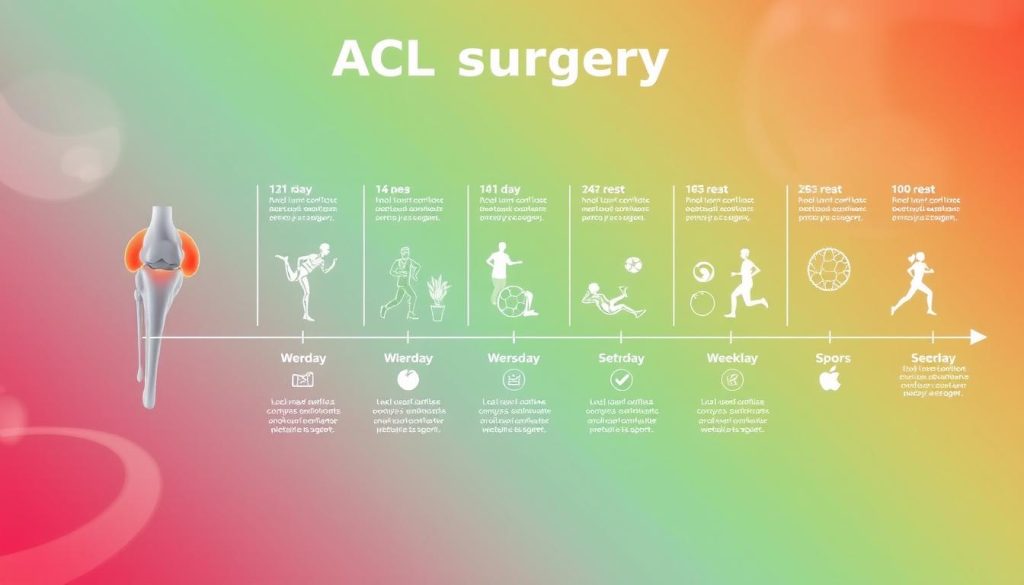
Normal Post-Surgery Symptoms
Some pain is okay after ACL surgery. You might see swelling, mild pain, and stiffness. These symptoms get better over time.
Bruising around the knee is also common. It should go away in about two weeks.
Deviation from Normal Recovery Patterns
It’s important to watch for bad signs after ACL surgery. Look out for severe pain, swelling that doesn’t go down, fever over 101°F, or trouble walking after a week. These could mean something’s wrong and you need to see a doctor right away.
| Normal Symptoms | Abnormal Signs |
|---|---|
| Mild pain and swelling | Severe, increasing pain |
| Temporary stiffness | Persistent joint locking |
| Gradual improvement in mobility | Sudden loss of motion |
Knowing the difference helps patients feel more confident in their recovery. If you’re unsure about your symptoms, always talk to a healthcare provider for advice.
Common Bad Signs After ACL Surgery to Monitor
After ACL surgery, it’s important to watch for signs of trouble. Spotting these early can help avoid serious problems and aid in a smooth recovery. Here are some common red flags to keep an eye on:
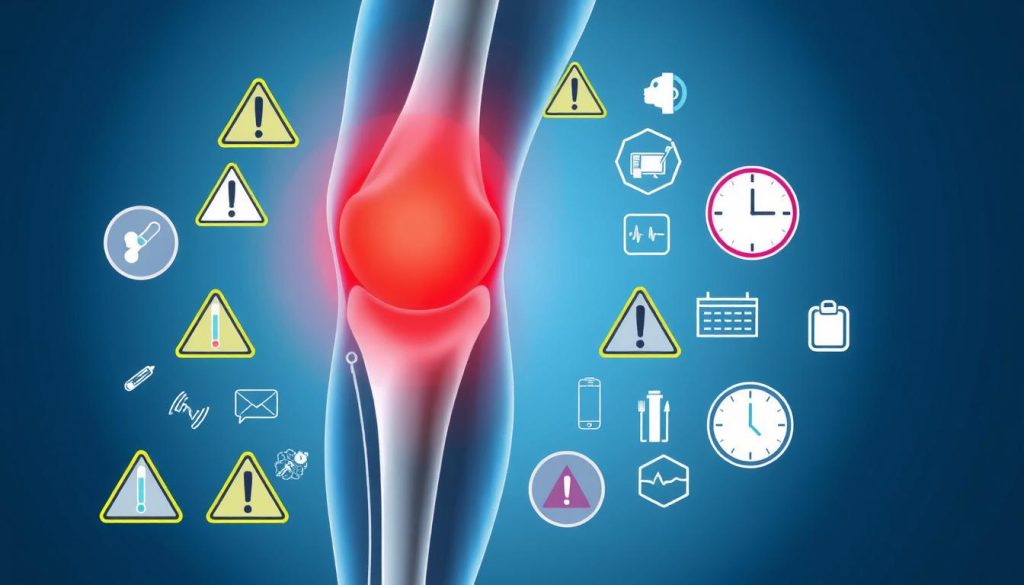
- Severe, persistent pain that worsens over time
- Excessive swelling that doesn’t subside with rest and ice
- Fever or chills, which may indicate infection
- Inability to bear weight on the operated leg after the recommended time
- Unusual warmth or redness around the incision site
- Drainage or foul odor from the surgical wound
- Numbness or tingling in the leg or foot
- Calf pain or swelling, which could signal a blood clot
Following post-surgery guidelines is key to avoiding complications. If you notice any of these symptoms, reach out to your healthcare provider right away.
| ACL Surgery Complication | Symptoms | Action Required |
|---|---|---|
| Infection | Fever, redness, warmth, drainage | Immediate medical attention |
| Blood Clot | Calf pain, swelling, warmth | Emergency care |
| Graft Failure | Instability, giving way sensation | Consult surgeon |
| Nerve Damage | Numbness, tingling, weakness | Inform doctor |
Being aware of these possible issues helps patients take charge of their recovery. Seeking medical help early can greatly improve the outcome of ACL surgery.
Severe Pain and Discomfort: When to Be Concerned
After ACL surgery, some pain is normal. But severe pain can signal problems. It’s important to know the difference for a smooth recovery.
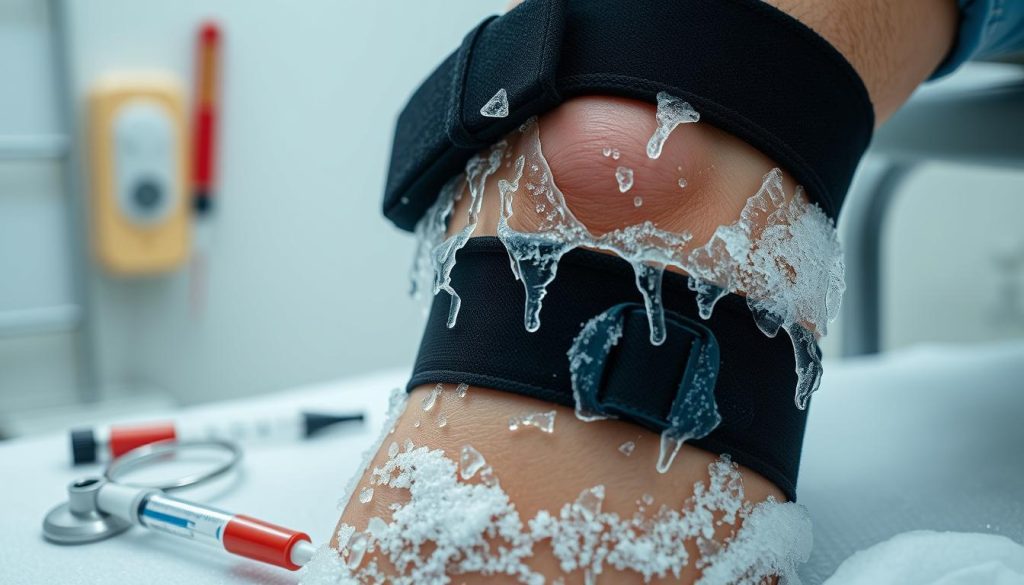
Distinguishing Normal and Excessive Pain
Normal pain feels like a dull ache or throbbing. It usually gets better each day. But, severe pain that gets worse or doesn’t go away with meds is a red flag.
Sharp, intense, or burning pain can mean there’s a complication.
Pain Management Red Flags
Watch for these warning signs of severe pain after ACL surgery:
- Pain that keeps you from sleeping
- Sudden increases in pain intensity
- Pain that spreads to other parts of your leg
- Throbbing or pulsing sensations in your knee
Impact on Recovery
Uncontrolled severe pain can slow healing. It may stop you from doing physical therapy, which is key for getting strong and mobile again. Also, it can cause stress and affect your mental health during recovery.
If severe pain after ACL surgery doesn’t get better with treatments, see your doctor. They can check on you and change your pain plan to help you recover well.
Post-Surgical Knee Swelling and Inflammation
Knee swelling after ACL surgery is common. Most people see swelling in the days after surgery. It’s a normal part of healing as your body reacts to the surgery.
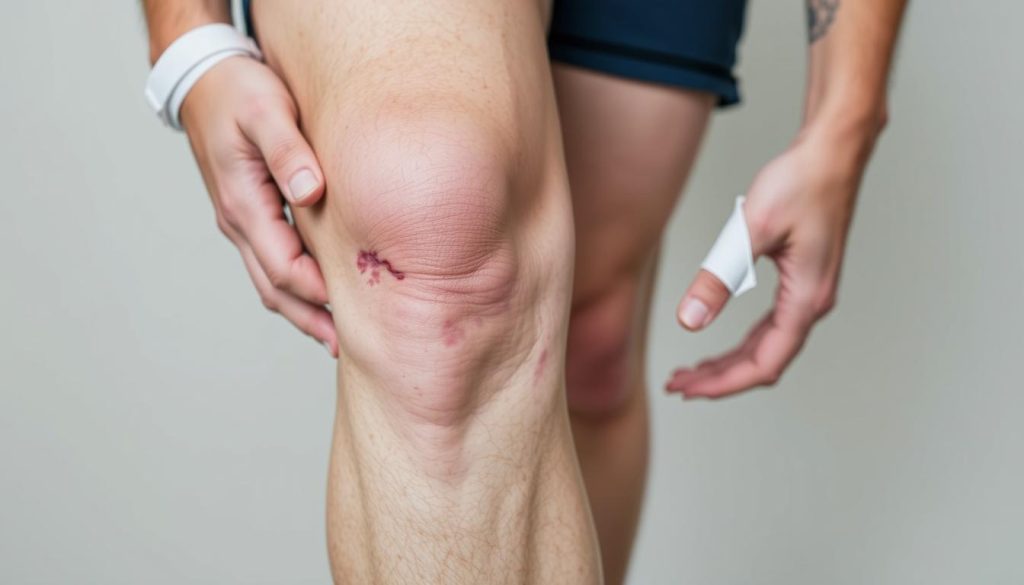
Swelling usually peaks in the first week after surgery. It can be uncomfortable and limit movement. Doctors suggest the RICE method to help:
- Rest: Avoid putting weight on your knee
- Ice: Apply cold packs for 15-20 minutes at a time
- Compression: Use elastic bandages to reduce swelling
- Elevation: Keep your leg elevated above your heart
Some swelling is okay, but too much or lasting swelling can mean trouble. If you see more pain, warmth, or redness, call your doctor right away. These signs could mean an infection or other serious problems.
Everyone recovers differently. Your surgeon will give you specific advice on handling swelling and when to get more help. Following these tips closely is key to a smooth recovery.
Identifying Signs of Post-ACL Surgery Infection
Infection after ACL surgery is a serious issue that needs quick action. Spotting early signs can stop severe problems and help with a smooth recovery.
Early Warning Signs of Infection
Look out for these symptoms at the surgical site:
- Increased redness or warmth
- Unusual swelling or tenderness
- Foul-smelling discharge
- Fever above 101°F (38.3°C)
- Persistent pain that worsens over time
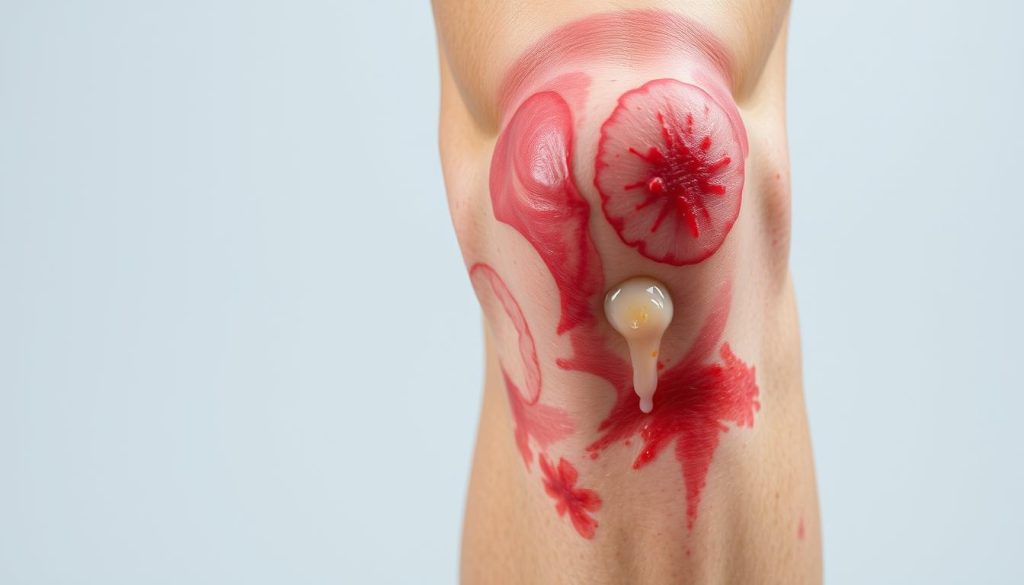
Risk Factors for Surgical Site Infections
Some factors can make you more likely to get an infection after ACL surgery:
- Diabetes
- Smoking
- Weakened immune system
- Poor nutrition
- Prolonged surgical time
Treatment Options for Post-Surgical Infections
If you think you have an infection, get help right away. Treatment might include:
- Oral or intravenous antibiotics
- Drainage of the infected area
- Surgical debridement in severe cases
- Extended hospital stay for monitoring
If you notice any infection signs after ACL surgery, call your doctor fast. Quick action can avoid big problems and help you heal well.
Range of Motion Problems After Surgery
After ACL surgery, getting back to full motion is key for a good recovery. Many face challenges with motion after surgery. Knowing when to worry about stiffness is important.
Patients should aim to fully extend their knee in the first few weeks. Flexion gets better over months. If you can’t bend or straighten your knee as expected, it might be a sign of a problem.
Several things can cause stiffness:
- Too much scar tissue
- Wrong rehab methods
- Complications from surgery
Sticking to your physical therapy plan is vital. Your therapist will help with exercises to boost flexibility and strength. If you’re not getting better, talk to your surgeon.
| Timeframe | Expected Range of Motion |
|---|---|
| 2-4 weeks | Full extension, 90° flexion |
| 6-8 weeks | Full extension, 120° flexion |
| 3-4 months | Full extension, 130°+ flexion |
Every recovery is different. If you’re worried or stiff, get checked out. Fixing motion issues early can avoid long-term problems and make recovery smoother.
Understanding Post-Operative Fever and Temperature Changes
After ACL surgery, your body temperature might change. This is normal as your body heals. But knowing when these changes signal a problem is key for a smooth recovery.
Normal vs Abnormal Temperature Variations
A slight fever after ACL surgery is common. Your body is working hard to heal, which can raise your temperature. A low-grade fever (up to 101°F or 38.3°C) in the first few days is usually not a cause for alarm.
Keep an eye on your temperature. If it stays below 101°F and gradually decreases, you’re likely on track. But if your fever spikes or persists, it’s time to call your doctor.
When Fever Indicates Complications
A high or lasting fever after ACL surgery can signal trouble. Watch for these signs:
- Temperature over 101°F (38.3°C)
- Fever lasting more than 3-4 days
- Chills or night sweats
- Increased pain or swelling
- Redness or warmth around the incision
These symptoms could mean an infection. Don’t wait to seek help. Early treatment is key to preventing serious complications and ensuring a successful recovery from your ACL surgery.
Excessive Bleeding and Drainage Concerns
After ACL surgery, some bleeding and drainage are normal. But too much bleeding can be a sign of a problem. It’s important to know what’s okay and what’s not.
Normal drainage is usually clear or a bit pink. It should get less over time. But if the bleeding is bright red and goes through bandages fast, it’s a big deal. You need to get help right away.
Watch your dressings closely. Change them when your doctor tells you to. If you’re changing bandages more than twice a day because of bleeding, call your surgeon.
If bleeding soaks through a bandage within an hour, seek medical help right away.
Good wound care can help avoid too much bleeding. Here’s what to do:
- Keep the incision site clean and dry
- Avoid touching the wound
- Don’t remove stitches or staples yourself
- Use ice packs to reduce swelling
Remember, too much bleeding after ACL surgery is not normal. It could mean an infection or a problem with the surgery site. If you’re worried, don’t hesitate to call your doctor.
| Normal Drainage | Excessive Bleeding |
|---|---|
| Clear or pink-tinged | Bright red |
| Decreases over time | Continues or increases |
| Minimal bandage changes | Frequent bandage changes |
| No fever | May include fever |
Numbness and Nerve-Related Complications
Numbness after ACL surgery is common. It’s important to know what’s normal and when to get help. We’ll look at typical numb areas and how long symptoms last.
Common Areas of Numbness
After ACL surgery, numbness often hits certain spots around the knee. These spots include:
- The front of the knee
- The outer part of the lower leg
- The top of the foot
Duration of Nerve-Related Symptoms
Numbness after ACL surgery usually lasts a few weeks to several months. Most people start to feel better in 3-6 months. In some cases, a bit of numbness might stick around for up to a year.
When Numbness Requires Medical Attention
While some numbness is okay, certain signs mean you should call your doctor:
| Warning Signs | Action Required |
|---|---|
| Numbness spreading beyond initial areas | Contact your surgeon |
| Persistent numbness after 6 months | Schedule a follow-up appointment |
| Numbness accompanied by severe pain | Seek immediate medical attention |
| Loss of movement in affected areas | Go to the emergency room |
Every recovery is different. If you’re worried about numbness after ACL surgery, talk to your healthcare provider. They can offer guidance and reassurance.
Graft Failure and Instability Signs
After ACL surgery, it’s important to watch for signs of graft failure or instability. These are serious issues that can stop your recovery and might need more medical help.
A feeling of the knee “giving way” during activities is a big warning sign. This can happen suddenly, with a sound like the original ACL injury. If you feel this, get medical help right away.
Other warning signs include:
- Not being able to put weight on the affected leg
- Swelling that doesn’t go away with rest and ice
- Stiffness or a decrease in range of motion that gets worse
- Pain that gets worse instead of better
Following your doctor’s instructions after surgery is key. Avoiding too much activity or high-impact sports too soon is important. It helps keep the graft safe and lets it heal right.
If you see any of these signs or worry about your knee’s stability, reach out to your surgeon. Quick action can stop more damage and help your ACL surgery succeed.
Physical Therapy Complications and Red Flags
Physical therapy is key for ACL surgery recovery. But, it comes with risks. Knowing bad signs during rehab can stop setbacks. Let’s look at common issues and how to spot them early.
Signs of Improper Exercise Execution
Wrong exercises can slow healing. Watch for these red flags:
- Sharp pain during movements
- Swelling that doesn’t subside
- Clicking or popping in the knee
- Inability to complete prescribed exercises
Recovery Setbacks During Rehabilitation
Setbacks can happen even with good care. Be alert for:
- Persistent stiffness in the knee
- Decreased range of motion over time
- Weakness that doesn’t improve with exercises
- Recurring instability when walking or standing
If you see these signs, talk to your physical therapist. They might need to change your program or send you back to your surgeon. Early action is vital to avoid long-term problems.
| Normal Progress | Potential Complication |
|---|---|
| Gradual pain reduction | Increasing or constant pain |
| Improved flexibility | Persistent stiffness |
| Increased strength | Muscle weakness or atrophy |
| Better balance and stability | Continued feelings of instability |
Remember, your recovery is unique. Listen to your body and talk openly with your healthcare team. This way, you’ll get the best results after ACL surgery.
Blood Clot Warning Signs and Prevention
Blood clots are a serious concern after ACL surgery. Knowing the warning signs can help prevent dangerous complications. Look out for symptoms of deep vein thrombosis (DVT) or pulmonary embolism.
- Swelling in the affected leg
- Pain or tenderness in the calf
- Warm skin around the affected area
- Redness or discoloration of the skin
Pulmonary embolism symptoms may include:
- Sudden shortness of breath
- Chest pain that worsens with deep breathing
- Rapid heartbeat
- Coughing up blood
Preventing blood clots is key for a safe recovery. Doctors often suggest early movement and wearing compression stockings. Some may need blood thinners.
| Prevention Method | Description | Effectiveness |
|---|---|---|
| Early Mobilization | Moving as soon as possible after surgery | High |
| Compression Stockings | Tight-fitting socks to improve blood flow | Moderate |
| Blood Thinners | Medication to prevent clot formation | High (for high-risk patients) |
If you think you have a blood clot, get medical help right away. Quick action can avoid serious complications and help you recover better.
Managing Medication-Related Complications
After ACL surgery, it’s important to manage your medications well. Knowing the bad signs of complications from your meds is key. This knowledge helps avoid setbacks and ensures you heal properly.
Pain meds and antibiotics are common after ACL surgery. They help you recover, but can have side effects. Watch for nausea, dizziness, or allergic reactions. Always follow your doctor’s dosage instructions and talk about any issues.
Some people may have bad reactions to their meds. These can include:
- Severe stomach pain or digestive issues
- Unusual bleeding or bruising
- Skin rashes or itching
- Difficulty breathing or swelling of the face
If you see these signs, call your doctor right away. They might change your meds or find other ways to help you recover.
| Medication Type | Common Side Effects | Warning Signs |
|---|---|---|
| Pain Medications | Drowsiness, constipation | Severe nausea, respiratory issues |
| Antibiotics | Mild stomach upset | Severe diarrhea, allergic reactions |
| Blood Thinners | Easy bruising | Excessive bleeding, chest pain |
Managing your meds well is vital for a smooth recovery from ACL surgery. Always talk to your doctor if you’re worried about your meds or notice any odd symptoms.
Long-Term Recovery Warning Signs
Recovery from ACL surgery doesn’t stop when you leave the hospital. Months or years later, patients might face bad signs. It’s key to spot these signs early to heal right and avoid surgery problems.
Chronic Pain Indicators
Long-lasting pain is a healing issue. If you have constant aching or sharp pains, see your doctor. These could mean inflammation, scar tissue, or other problems.
Persistent Stability Issues
Your knee should get stronger as you heal. But, if it feels unstable or wobbly, it might not be healing right. Doing exercises and physical therapy helps keep your knee stable.
Impact on Daily Activities
Long-term issues can really hurt your daily life. Watch how your knee affects your routines. Trouble with stairs or avoiding sports are warning signs you need to see a doctor.
| Warning Sign | Possible Cause | Action |
|---|---|---|
| Chronic pain | Inflammation, scar tissue | Consult doctor |
| Persistent instability | Incomplete healing, graft failure | Physical therapy, medical evaluation |
| Limited daily activities | Ongoing knee issues | Discuss with healthcare provider |
Successful recovery needs constant watchfulness. Don’t ignore these signs. Tackling them quickly can stop more problems and help your ACL surgery succeed.
When to Contact Your Healthcare Provider
After ACL surgery, it’s important to watch for bad signs. These signs might mean you have a complication. If you see any of these, call your doctor right away:
- Severe pain that doesn’t improve with prescribed medication
- Excessive swelling or redness around the surgical site
- Fever above 101°F (38.3°C)
- Unusual discharge or foul odor from the incision
- Inability to bear weight on the operated leg after the recommended period
- Numbness or tingling in your foot or toes
- Signs of a blood clot, such as calf pain or swelling
When you call your doctor, be ready to talk about your symptoms. Tell them when you first noticed them, how bad they are, and what makes them better or worse. This info helps your doctor figure out what’s going on and what to do next.
If you’re not sure about a symptom, it’s always safer to call your doctor. They’re there to help you get better and answer any questions you have.
Emergency Situations Requiring Immediate Medical Attention
Most ACL surgery recoveries go well, but some situations need fast action. Severe pain that doesn’t go away with medicine is a warning sign. If you’re in too much pain, get help right away.
Bleeding a lot from the surgery area is another danger sign. A little bit of discharge is okay, but a lot might mean the wound isn’t healing right. If this happens, apply gentle pressure and contact your healthcare provider immediately for advice.
Feeling feverish, or seeing more redness, warmth, or swelling around the incision, means you need to see a doctor fast. These could be signs of infection, which need quick treatment to avoid bigger problems.
Also, watch for signs of blood clots, like shortness of breath, chest pain, or swelling and tenderness in your calf. These are emergencies that need immediate attention. By being quick to notice and act on these signs, you can get the best results from your ACL surgery.
FAQ
Q: What are the most common bad signs after ACL surgery?
A: Look out for severe pain, too much swelling, and signs of infection like redness and warmth. Fever, trouble moving, numbness, and too much bleeding are also warning signs. If these get worse or don’t go away, call your doctor.
Q: How can I distinguish between normal and excessive pain after ACL surgery?
A: Normal pain gets better over time and can be managed with meds. But, if pain gets worse, feels sharp, or doesn’t get better with meds, it’s a red flag. Seek help if pain is severe.
Q: When should I be concerned about swelling after ACL surgery?
A: Swelling is normal at first and usually goes down in a week. But, if it lasts more than 2-3 weeks or gets worse, it could be a problem. See a doctor if it’s red, warm, and swollen.
Q: What are the signs of infection after ACL surgery?
A: Watch for redness, warmth, foul-smelling discharge, fever over 101°F, and more pain. If you see these signs, get medical help right away.
Q: How long should I expect to have limited range of motion after ACL surgery?
A: You might not move as well at first, but it should get better in a few weeks. If it doesn’t, talk to your doctor.
Q: Is numbness after ACL surgery normal?
A: Some numbness is okay and usually goes away. But, if it lasts a long time or gets worse, it could mean nerve damage. See a doctor if it’s a concern.
Q: What are the signs of a blood clot after ACL surgery?
A: Look out for swelling in the calf, warmth, redness, and pain in the leg. Shortness of breath is also a warning sign. These are serious and need immediate attention.
Q: How can I tell if my ACL graft has failed?
A: If your knee feels unstable, you can’t put weight on it, or there’s a lot of swelling, it might be a sign of failure. A popping sound like your injury is also a bad sign. If you notice these, call your surgeon.
Q: When is it safe to return to normal activities after ACL surgery?
A: It depends on how you recover and what you’re doing. You might be back to daily stuff in 2-3 months. Jogging can take 4-5 months, and sports might take 6-12 months. Always listen to your doctor and physical therapist.
Q: What should I do if I experience a fever after ACL surgery?
A: A low fever is okay for a few days after surgery. But, if it lasts more than 3-4 days or gets too high, call your doctor. Also, if you have chills or redness, get help right away.












